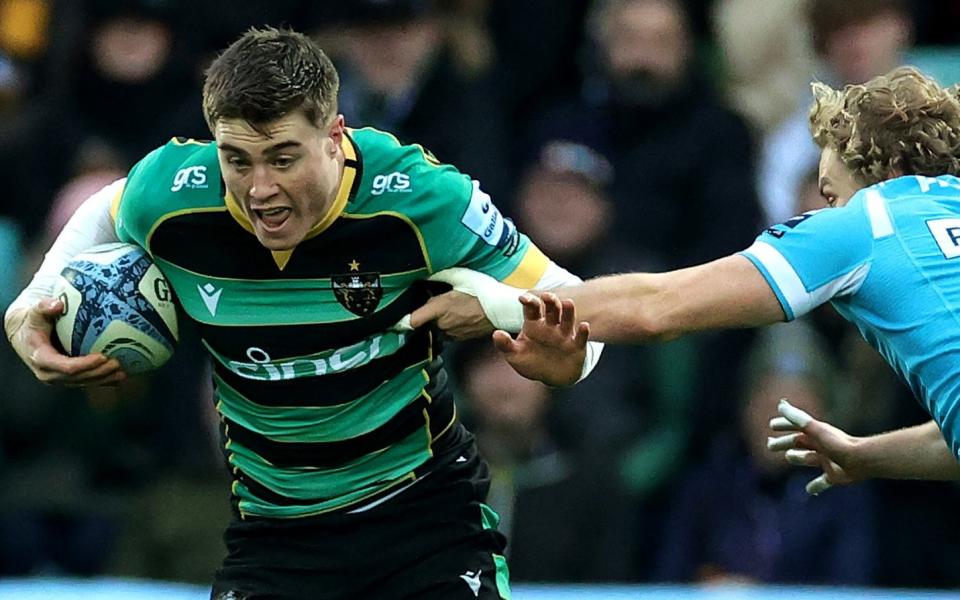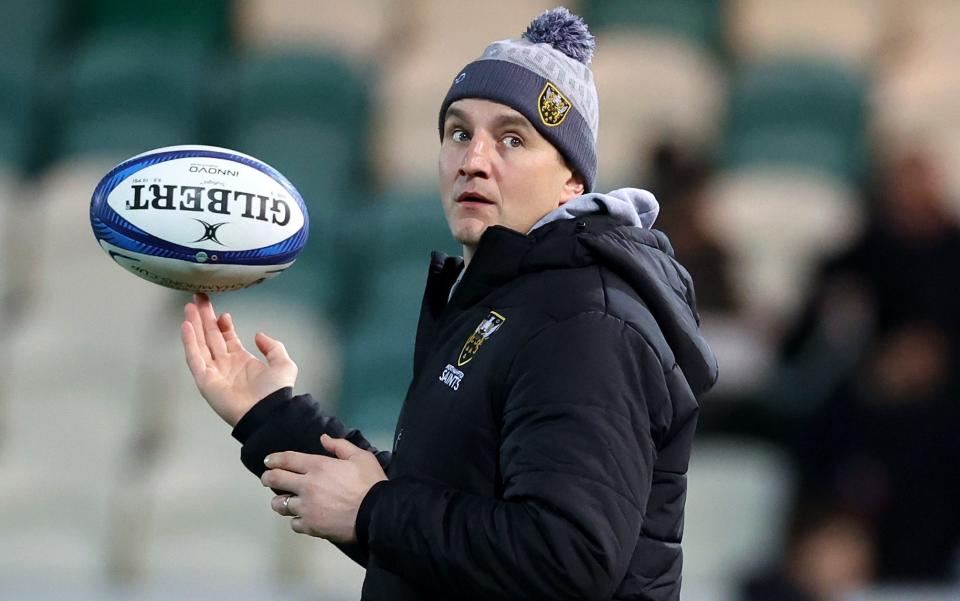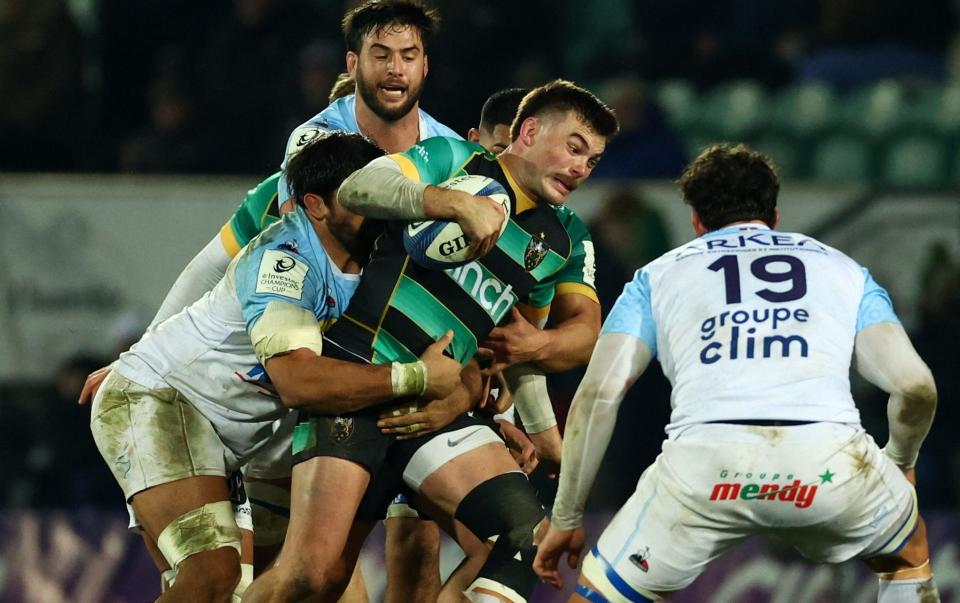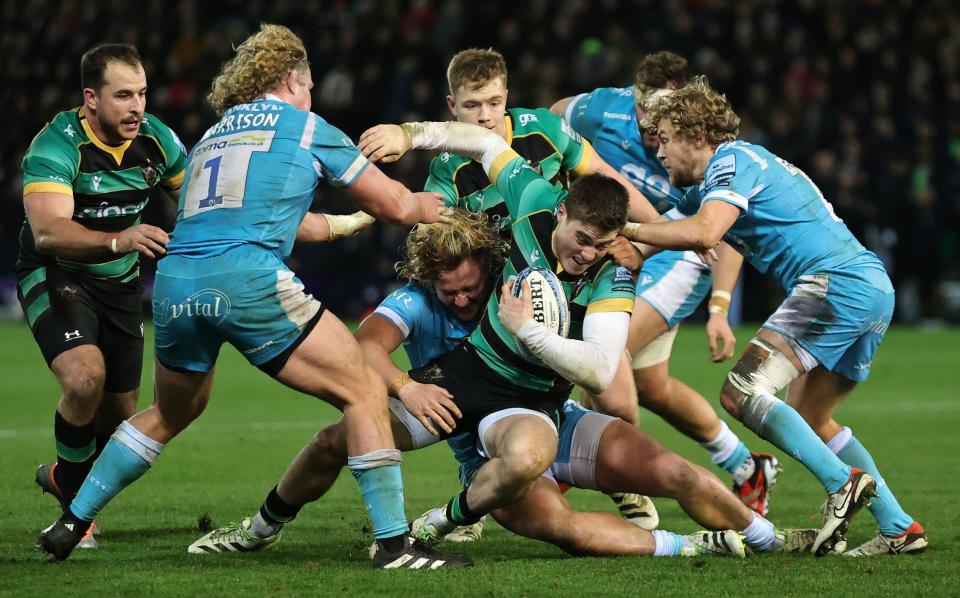Northampton’s squad bulk: Heavy shakes and heavier weights propelling Saints’ charge

It has been more subtle swell than incredible bulk, but a concerted strategy of squad-wide weight-gain and strength training has bolstered Northampton Saints and driven their success so far this season. Top of the Premiership and unbeaten in Europe, through to the last 16 of the Champions Cup after thrashing hapless Bayonne 61-14 on another intoxicating Friday night at Franklin’s Gardens, they must feel that bigger is proving to be better.
Last spring, Phil Dowson, the club’s director of rugby, sat down with head coach Sam Vesty and Tommy Bullough, head of athletic performance, to ponder playing style. During the tenure of Chris Boyd, Dowson’s predecessor, speed was all important. For the next campaign, they wanted to galvanise the free-flowing approach that had become their trademark.
“We couldn’t get the game to go quickly enough at times,” Dowson says. “It can be quite easy [for opponents] to slow a game down, so being a bit lighter and fast wasn’t paying off, especially in the winter months.”
Over the past three completed Premiership seasons, between 2020-21 and 2022-23, Northampton won just 25 per cent of domestic fixtures in November and 33 per cent in December. This season, they won seven of eight in the league across those two months. They are now two from two in January before a trip to face Munster at Thomond Park.
Dowson stresses that a collective gain, which was implemented across backs as well as forwards, came alongside other transformative factors including a more confrontational mind-set and Lee Radford’s arrival as defence coach. The integration of recruits such as Curtis Langdon, Temo Mayanavanua and Tom Pearson meant the group was different, too.

“There were loads of things we spoke about around how we could be better,” Dowson says. “We needed to be better at defence. We needed to be better away from home. We wanted to be slightly heavier, but we also wanted to play fast and not move too far away from our DNA.
“We spoke about how we could integrate that into our pre-season – not to put tons of weight on or change the dynamic totally, but to be more powerful and carry more muscle mass into the collisions.”
‘You can’t just bang weight on and expect to run’
Crucial to planning was the time afforded by the World Cup. Players began filtering back into the club towards the end of June, some four months before league fixtures would begin. As Dowson explains: “You can’t just bang weight on and expect to run because it comes with an injury risk.” Bullough, who first arrived at Saints from an internship at Sale Sharks in 2008, devised the schedule.
“We’ve always lifted [weights], but what we’ve seen as coaches is that lots of teams have tried to bulk and they literally just bulk,” he says. “We thought that would lead to a lot of soft tissue injuries [strains and sprains of muscles, ligaments and tendons], so we tried to keep an undercurrent of fitness and running throughout the whole thing.
“We were still touching the ball a lot, still doing lots of skills and working on basic rugby stuff, but without that being detrimental to the lifting.”
For the first six-week ‘block’, the Northampton squad underwent between six and eight weights sessions per week, with most of the lifting at around 90 per cent of players’ maximum effort. There were two rugby sessions, one on a Tuesday and one on a Friday, after a skills session on the Monday. Strength and conditioning staff monitored individuals’ running output and aimed to cap everyone at 10 kilometres per week, a “reasonably low” load. Diet obviously contributed, too.
“It wasn’t focusing on lean mass, it was just mass,” says George Furbank, who now tips the scales at around 93kg after adding about three kilograms. “That didn’t happen by eating Maccies every day. It was still food I enjoy eating – not just chicken, rice and veg.

“We had heavier shakes at the club with a bit more milk products and creatine and we were loading up on carbs as well. You can see carbs as a bad thing but when you’re trying to put on weight, and then you’re doing as much training as we were, they’re pretty important. It was mainly just more of what I like eating. When eating becomes a chore, that’s when it is difficult.”
Tom Lockett and Emeka Atuanya, two young locks, are name-checked as impressive gainers. James Ramm and George Hendy in the back three are also volunteered. Tommy Freeman, who earned an England call-up alongside six club colleagues including Furbank, Alex Coles and Fraser Dingwall, has looked more muscular as well. Emmanuel Iyogun, the loosehead prop who ruptured his Achilles tendon against Exeter Chiefs a year ago, had been something of a “guinea pig” during a long stretch of rehabilitation.
“We deemed Manny to be a light prop,” Bullough says. “He put on seven kilos between his injury to the start of pre-season and his strength improved massively. We’re really proud of him. As someone who has historically struggled to hold weight, he’s holding 120kg now.”
Intriguingly, Dowson reveals that it was easier to achieve buy-in because some players had received feedback “either on the international stage or from what they’d felt in games” suggesting that a few extra kilograms would help them. As an amusing motivator, Bullough introduced the award of string vests – “proper muscle beach ones” – for good performances in the gym.
‘We were conscious of not losing our speed’
“Everyone has a level of vanity about them and the lads saw the weights they were moving,” he says. “It’s a common myth across sport that, as you get bigger and heavier, you lose your speed. We were conscious of not losing our speed, so we kept the [sprinting] mechanics in [the programme], even if we weren’t running as much as we normally would.
“Once the lads thought, ‘I’m not slowing down, I’m getting stronger in the gym and my fat percentage is going down – I generally look better in the mirror’, I think they generally bought in.”
As the summer wore on, the number of weekly lifting sessions reduced to five or six and running increased again. Fin Smith won Northampton’s annual Blakiston Challenge, a gruelling fitness task, at his first attempt. Encouragingly, though, a culture of relishing weights had been instilled.

“It’s very easy, when you get into the season particularly, to wander through gym sessions,” Furbank says. “I think we now realise the importance of those sessions and the importance of that weight. We’ve seen the benefits of it and there has definitely been a change in mind-set in that area.”
Here is the crux. Saints have demonstrated tangible rewards of this additional size. In the Premiership, according to Stats Perform, their tackle success has risen from 85 per cent to 89 per cent. Their carry dominance is also up from 26 per cent to 48 per cent. Furbank, who has worked hard on his gluteal and hamstring strength to improve leg-drive in contact, looks noticeably more powerful. The 27-year-old has punched holes on the counter as well as finding space as a playmaker.
Among their most dogged displays have been a 28-19 victory over Glasgow Warriors at a sodden Scotstoun and a comeback defeat of Sale Sharks. Alex Sanderson admitted that his side found themselves “in the tumble dryer”, such was Northampton’s physical supremacy. All the while, Saints have attacked with incision, pace and skill.
Bullough knows it is essential to retain an explicit link with rugby. Northampton’s conditioners are assigned to positional groups and work closely with coaches. As another example of motivating players, Vesty and Ben Rhodes have presented backs with their in-game momentum scores, calculated by multiplying mass by speed.
“We’re not training weightlifters or sprinters exclusively,” Bullough says. “It’s all very joined up. Our job as a strength and conditioning department is to provide the coaches with the players they want to play the game.”
A bit of ballast has helped to balance Northampton and brace them for winter. The business end of the season, where silverware is won, will be upon us soon enough.

 Yahoo Sport
Yahoo Sport 





































